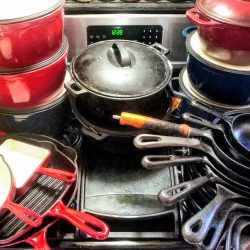
Many people struggle to cook good rice, particularly brown rice which is certainly more challenging. But rice is probably the most widely eaten grain in the world, and with a few simple little tricks, its not as hard as you might think it is.

Its important to know what kind of rice you have, since each type of rice cooks a little differently, and is used for different purposes. The upper left rice in the photo above is a brown sticky rice, and is typically used for sushi and dessert preparations; I cooked this one with the pasta method, which I will explain down below. The upper right hand corner is Arborio rice, which is an Italian medium length rice grain, and is used for making risotto, a dish that I will be doing later this week, The lower left is a jasmine rice, a long grain rice that has a beautiful scented rice that comes from south East Asia. In the lower right is basmati rice, an extra long grain rice that has a rice nutty flavour, and my personal go-to rice for most dishes.
To successfully cook brown rice, I tend to go with what is referred to as the pasta method. Its pretty simple, just like pasta, you are going to cook it in an excessive amount of water. In the video below, I used about 4-5 cups of water to cook 1/2 cup of rice. It took nearly 45 minutes, and there was very little water left. Don’t forget to salt your water.
Basmati rice, as I noted, is my go-to rice, but does not use the traditional 2-to-1 water to rice ratio that most think of when cooking rice, and there are a few extra steps that I follow, but it makes a huge difference. Try this method next time.
- Wash rice under cold running water. I tend to use a strainer, but you can do it in a bowl. The goal is to see nice clear water so that you know you have washed all excess outer starch off of the rice.
- Add your rice to the pot and water at a 7-to-4 ratio. This means for every cup of rice that you have you should use 1 &3/4 cups of water. Toss in 1/2 tsp of salt.
- Let the rice sit in the cold water for 10 minutes.
- After the rice has sat, bring to a boil, and reduce the heat to low, allowing to simmer for 10 minutes.
- After it as simmered, remove from the heat, and let it sit for 10 minutes.
- Fluff with a fork and serve.









